Exploring the Boneless Skate: Techniques and History
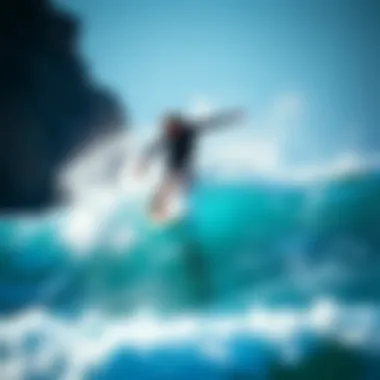
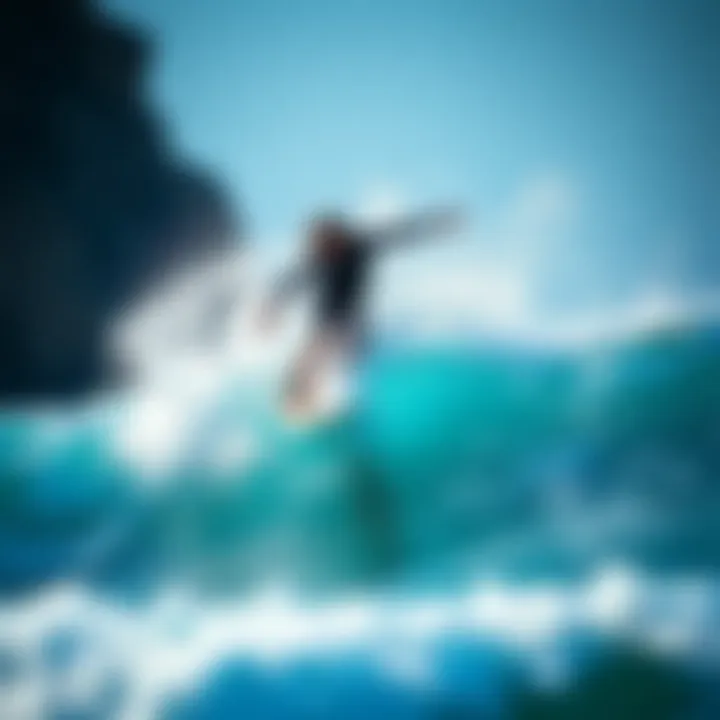
Intro
Surfing isn't just a sport; it's a way of life. Among the myriad of techniques that populate the sloshing world of surfboarding, the boneless skate stands out as a hallmark of creativity and athletic skill. Originating from a playful fusion of tricks and techniques, this maneuver has evolved to become a fundamental aspect of modern surf culture. In this article, we will peel back the layers to reveal the history, the techniques, and the impact of the boneless skate, providing a thorough understanding not just for experts, but also for enthusiasts keen to delve into this rich cultural tapestry.
Surfboard Technology
Surfboard design and materials play a significant role in the execution of the boneless skate. Innovations in technology have led to boards that are lighter and more agile, giving surfers a distinct edge in performing complex maneuvers.
Innovations in Surfboard Materials
Gone are the days of heavy, cumbersome boards. Today's surfboards often employ advanced materials such as epoxy and carbon fiber, which enhance performance by reducing weight and improving durability. These materials not only facilitate the quick flick needed for executing a boneless, but also lend themselves to a diversity of board shapes that cater to various surfing styles. The integration of eco-friendly materials is also evident, appealing to the growing number of environmentally-minded surfers.
Comparing Different Surfboard Shapes
Understanding the specific shapes of surfboards can significantly affect how well one can execute a boneless.
- Shortboards: Ideal for tricks, these are typically under 6 feet, allowing for snappy turns and agile movements.
- Fish Boards: Wider and shorter, they offer stability and can be more forgiving for beginners learning to navigate their first maneuvers.
- Funboards: A hybrid that provides both speed and manageability, these are good for surfers who are in that transition between novice and expert.
It's important for any aspiring surfer to find a board shape that resonates with their personal style and comfort level.
Surfing Techniques
To truly master the art of the boneless skate, a solid foundation in surfing techniques is vital.
Essential Skills for Beginners
Starting with the basics, here are a few essential skills every new surfer should refine:
- Paddling: The lifeblood of surfing; efficient paddling is crucial to catching waves.
- Balance: Practicing balance on the board can lead to smoother rides.
- Wave Selection: Knowing which waves to ride is as important as the skill level itself.
Advanced Maneuvers for Experts
Once you've mastered the fundamentals, it’s time to delve into more advanced techniques:
- Boneless Trick: This involves taking the board off the water, briefly leaving the surfer airborne before landing back on it. Execution is all about timing and body positioning.
- Air revs and spins: Quick rotations while airborne can add flair to your performance, but they require practice to nail down.
- Combining Tricks: As you gain experience, experiment with combining tricks to create your own unique style, blending the boneless skate with other moves.
"The joy of surfing is often found in the synthesis of the past with the novelty of the present."
The boneless skate reflects just that—a technique steeped in history, yet alive and thriving in today's surf culture.
For those looking to delve deeper into the subject, resources such as Wikipedia and Britannica offer rich insights. Surf community forums on Reddit can also provide peer advice and camaraderie as you journey into mastering this delightful art.
Expect the following sections to further unpack the boneless skate's historical significance and highlight notable practitioners who have left their mark on the surfboarding culture.
Prelims to Boneless Skate
The boneless skate serves as a cornerstone within the realm of surf culture. It’s not merely a technique; it embodies a way of life, a style of expression that resonates with countless surfers across the globe. Understanding the nuances of this particular maneuver not only enhances the skill set of aspiring surfers but also deepens their appreciation for surf history and culture. As we navigate through the technical, historical, and cultural facets of the boneless skate, it becomes evident why this technique holds such significance in the surf community.
Defining the Boneless
To comprehend the boneless skate, one must start with a clear definition. Essentially, a boneless is a move performed by grabbing the board while using one foot, usually the back foot, to push off the wave or the surface beneath. The rider lifts the board, getting air while using that momentum to execute a trick or simply to enhance their ride. It’s a fluid action that merges style with the physics of surfing. Unlike some technical moves that can appear stiff or overly rehearsed, the boneless emphasizes the rider’s connection to the board and the water, showcasing a seamless blend of balance and control.
Significance in Surf Culture
The boneless skate represents more than just a technical feat; it’s a code of authenticity in surf culture. Originating in the early days of skateboarding and surfboarding, surfers adopted the essence of this maneuver as a way to show their creativity and personal flair. The impact stretches far beyond the waves, influencing art, music, and lifestyle choices within the surfing community.
Surfers who execute boneless tricks convey a sense of freedom, breaking from the confines of traditional wave riding. It’s a statement that resonates throughout the surf world: it’s not just about catching waves, but about expressing individuality on the water.
"The boneless is not merely a trick; it’s a lifestyle that encapsulates the essence of freedom and creativity in surf culture."
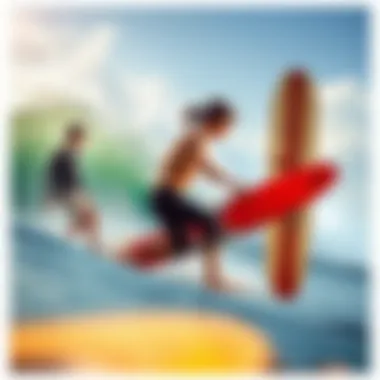

The continuous evolution of this technique also mirrors the changing tide of surf culture itself. As new riders adopt and adapt the boneless, it ensures that the spirit of innovation remains alive. The technique has paved the way for future generations, inspiring many to incorporate their own unique styles.
In summary, the boneless skate is integral to understanding surf culture. It serves as a bridge linking the technical and artistic aspects of surfing, making it essential for anyone who wishes to dive deeper into what surfing truly represents.
Historical Context
Understanding the historical context of the boneless skate technique is vital to grasping its role within surf culture. This section dives into the roots of the boneless, shedding light on how it emerged and altered the surfing landscape. By tracing its origins and evolution, readers can appreciate not just the technique itself, but also the cultural tapestry woven around it.
Origins of the Boneless Technique
The boneless skate technique traces back to the 1980s, a time when surfing was growing rapidly in popularity and diverging into various styles and practices. Illustrating an attitude of freedom, the boneless was initially conceptualized by surfers looking for ways to express themselves through creative aerial maneuvers. Early adopters like Tony Alva and Jay Adams were notorious for pushing boundaries, drawing influence from skateboarding, which was deeply entwined with surf culture.
One cannot talk about the boneless without mentioning the first documented instance of the maneuver: it’s said that it appeared when surfers realized they could achieve lift and style while freeing one foot from the board. While the technique grew in effectiveness, it simultaneously became a medium to showcase individuality. Instead of merely riding waves, surfers could now perform an artful display that clearly set them apart.
Evolution through the Decades
As the decades rolled on, the boneless skate continued to grow and adapt, merging various elements from the surfing and skateboarding worlds. In the 1990s, the move gained more prominence as surfers began to include it in their repertoires for contests and exhibitions. The likes of Kelly Slater and Rob Machado began incorporating the boneless into their routines, showing how versatile and impactful it could be.
Over time, the boneless transitioned from a niche trick to becoming a staple in competitive surfing. The adaptation of the technique was fascinating: what began as a simple maneuver turned into a sophisticated presentation of skill and artistry. With rising technology in board design and surf conditions becoming more optimal, the boneless technique marked a turning point—riders now employed it in various styles, from high-energy competitions to casual surfing at beach breaks.
"Surfing and skateboarding are synonymous when it comes to self-expression; the boneless is just one way to showcase that ethos."
Today, the boneless is more than just a trick—it's a symbol of freedom and creativity in the surfing world. Its roots tell a story of how a simple act of lifting one foot from a surfboard could lead to a whole culture of innovation. Learning about the historical context of the boneless exudes an awareness of how cultural practices evolve and intermingle, offering meaningful insights into modern surfing techniques and styles.
Technical Aspects of the Boneless
Understanding the technical aspects of the boneless skate holds great significance for those who wish to deepen their practice in surfboarding culture. The boneless isn’t just a flashy move; it embodies a level of skill, body awareness, and adaptability that inspire both awe and respect among surfers. This section will dissect the foundational elements needed to execute a boneless, the variations that can be applied, and the nuances of mastering this technique.
Basic Movements Explained
At its core, the boneless involves both feet engaging in a dance with the board, creating a seamless transition between air and water. The key movements can be broken down as follows:
- Foot Placement: Keeping your back foot above the tail of the board while the front food ventures towards the edge is crucial. Without the correct positioning, achieving the lift you need for the maneuver becomes problematic.
- Body Dynamics: The upper body must lean slightly forward as you prepare for the boneless. This forward lean helps create momentum. As the board is lifted, twisting the torso while keeping the eyes on the intended landing area aids in control.
- The Pop: The action of popping the board off the water primarily comes from your back foot. A sharp flick up while simultaneously using your front foot to pull the base of the board engages the next phase of the move.
- Reaching Down: With a slight bend in the knees, reach down and grab the board. This step is not just for show; it stabilizes your trajectory in the air. If you miss this beat, the entire trick can go sideways.
Common Variations
Once the basics are squared away, surfers can experiment with several variations of the boneless, each offering its own flavor and challenge:
- Boneless 180: Rotate the board in a half-turn while executing the grab. This adds an extra dimension to the boneless, making it visually appealing.
- One-Footed Boneless: This variation involves reaching down with one foot off the board, leaving the other for balance. The risk here increases, but so does the thrill and skill display.
- Boneless with a Grab: Adding a stalling grab during the air phase may yield a new aesthetic, showcasing more individual style in your approach.
Each variation invites surfers to express their unique interpretations, further enriching the collective experience within surfing culture.
Mastering the Technique
Achieving mastery in the boneless is a journey that requires practice and a strategic approach to overcoming common pitfalls:
- Practice Regularly: Frequent drills focusing on foot placement and timing can pave the way for smoother executions.
- Visualize the Move: Before attempting a boneless, visualize every segment. Many athletes utilize mental rehearsals to prepare their bodies for the actual movements.
- Record and Review: Filming yourself while attempting the move can help identify gaps in performance. Observing the playback provides insight that mere reflection cannot.
- Stay Relaxed: It's easy to tense up when aiming for perfect execution, but staying loose allows freer movement and better judgment mid-move.
- Seek Feedback: Engaging with fellow surfers or a mentor can provide constructive criticism that refines your approach.
"The boneless isn’t just about carving the waves; it's an art form illustrating the harmonious relationship between the surfer and their board."
For further reading, consider resources such as BBC Sport or the Wavescape website for detailed insights on surfing techniques and culture.
Influential Riders
The world of surfboarding has seen its fair share of skilled individuals who have pushed the boundaries of what is possible on the waves. The term "Influential Riders" refers to those surfers who have not only mastered the boneless skate but have also shaped the culture and techniques associated with it. These pioneers and practitioners play a vital role in both inspiring new generations and honing the artistry of surfing itself. Their techniques and styles often reflect the evolution of the sport, bridging the past and present while paving the way for future developments.
Pioneers of the Boneless
The roots of the boneless skate technique can be traced back to a few key individuals who truly defined and popularized it. Among these pioneers, Christian Hosoi stands out due to his early adoption and innovative flair. In the 1980s, he introduced this move, showcasing not only technical skill but also distinct style. "The way he infused personality into the sport was electric. It wasn't just about the tricks; it was about expression," recalls longtime surf enthusiast Ben Cooper.
Another essential figure is Tony Hawk, who while primarily a skateboarder, demonstrated how various actions could translate across different boards. His influence helped expand the boneless' popularity into skate culture, showing that the move could be performed on ramps as well as in the surf. This cross-pollination of techniques continues, embedding the boneless deeper into both sports.


Contemporary Practitioners
Fast forward to today, and the trends keep evolving with a whole new breed of surfers taking the boneless skate to new heights. Surfers such as Kanoa Igarashi and Carissa Moore embody the modern approach, merging traditional techniques with contemporary twists. Each of these athletes often incorporates their own personal style, allowing room for creativity while paying homage to their roots.
Consider Kaimana Jaquias, who is known for his seamless combos and daring executed boneless moves in competition. He showcases how mastering the basics can lead to radical variations that resonate well with fans. Similarly, Carissa Moore doesn’t just stick to the standard; her adaptations reflect a keen understanding of wave dynamics, enabling her to fully exploit her surroundings. Today they embody the passion for fusion not only enhancing their performances but revitalizing interest in the boneless.
Impact on Competitive Surfing
The boneless technique has also made a significant footprint in competitive surfing. Events like the World Surf League have seen an increase in maneuvers using the boneless as a focal point. This move's incorporation into competitive routines has expanded the criteria for scoring, allowing surfers to showcase their ability to combine power with grace. For instance, judges are now looking for creativity, and the boneless provides a perfect chance to impress.
Moreover, as the sport evolves, so does the judging system. Competitions recognize the importance of diversity in moves and styles, making the boneless instrumental in attracting a wider audience. The inclusion of such techniques has given rise to a new standard, prompting surfers to innovate continually, keeping the sport dynamic.
In sum, the influence of the "Influential Riders" cannot be overstated. They provide inspiration, contribute to ongoing discussions about technique evolution, and serve as models for aspiring surfers. Understanding their roles helps contextualize the boneless technique within the larger tapestry of surfboarding culture—a testament to both its past and its promising future.
Cultural Impact of the Boneless
The boneless skate holds a unique position in the fabric of surf culture, transcending its technical aspects to become a cultural statement. This is more than just a trick; it's a vibrant expression of identity, creativity, and individuality among surfers. Understanding its cultural significance involves delving into how it is represented in media and how it influences surf fashion.
Representation in Media
Media plays a crucial role in shaping the perception of surfing techniques, and the boneless is no exception. A wide array of movies, documentaries, and online videos have showcased this technique, embedding it deeply in the mind of the public. Films like "Step Into Liquid" and various surf documentaries frequently feature the boneless, which helps solidify its place within surf lore. By capturing the thrill and skill involved in executing a boneless, media portrayals elevate the technique from a mere movement to an awe-inspiring spectacle.
Moreover, social media platforms, particularly Instagram and TikTok, have allowed surfers to share their personal takes on this technique with a global audience. Influencers and everyday riders post clips showcasing their skills, often adding personal flair such as unique stylistic spins or variations, further promoting the boneless skate as an integral part of contemporary surf culture. These clips generate trends, encouraging a new generation of surfers to adopt and adapt the technique.
"The boneless isn’t just about the trick; it’s about the connection to the ocean and the culture that surrounds it."
Thus, representation in media not only entertains but also educates and inspires. It invites viewers into the rich tapestry of surf culture, fostering a shared sense of community and aspiration among fans.
Influence on Surf Fashion
Alongside media representation, the boneless has significantly influenced surf fashion. Surfers, particularly those who embrace this style, are often seen as trendsetters. The trick itself conveys a sense of daring and creativity which permeates clothing styles and gear.
For instance, brands like Rip Curl and Billabong have incorporated the daring spirit of the boneless into their collections. Designs that nod to the vibrant lifestyle of surfers often feature elements inspired by the tricks themselves. Graphic tees, board shorts, and surfboard designs echo motifs associated with boneless skates, linking the fashion directly to the surf culture.
Moreover, the casual yet edgy style reflected in boneless execution is apparent in streetwear trends. The skateboard influence on surf fashion cannot be overlooked, as many surfers adopt unique casual looks that emphasize comfort and durability, emulating their board-riding heroes. This crossover between skateboarding and surfing fosters a united front, promoting a lifestyle that embraces adventure and self-expression with flair.
In summary, both the representation in media and the influence on fashion highlight the boneless skate as more than a skillful technique; it represents a rich culture of creativity, identity, and community. As surfers continue to evolve this technique, it is likely that the cultural impact of the boneless will only deepen, inspiring future generations to ride the waves with style and fluidity.
Boneless Skate in Other Sports
The boneless skate technique has not just captured the hearts of surfers; it has also made significant waves in other action sports. The adaptation of this iconic movement in skateboarding and snowboarding demonstrates the intersection of athletic skills, creativity, and cultural expression. Understanding these crossovers provides insight into the broad appeal and versatility of the boneless skate.
Crossovers with Skateboarding
The synergy between surfboarding and skateboarding is nothing new. Many surfers find common ground in skateboarding, and it’s no surprise that the boneless maneuver has crept into skate parks across the globe. In skateboarding, a boneless serves not only as a basic trick technique but also as a means to showcase one's distinct style.
- Fluidity of Movement: Just like in surfing, executing a boneless on a skateboard involves a fluid transition that requires balance, timing, and control. The beauty of the boneless lies in how it connects the flow of tricks, allowing riders to launch off ramps or ledges with an effortless-looking confidence.
- Creative Variations: Skateboarding brings its own flair to the boneless. Think of variations like the boneless grab, where the rider reaches down to grab the board mid-air, adding significant style points to the flip. These variations not only build on the technique but also push the creative boundaries of what can be done with the trick.
- Cultural Fusion: The blending of surf and skate culture has influenced many a rider's identity. Communities often overlap, with events celebrating both sports. Riders who can master the boneless in both arenas find unique ways to express themselves through their respective crafts.
Adoption in Snowboarding
As surf culture drifts into the snow, the boneless has found a new home on the slopes as well. Snowboarding borrows many elements from skateboarding and surfing, making the transition of the boneless from water to snow seem almost seamless. Here’s how the boneless manifests itself in snowboarding:
- Unleashing Tricks Off Jumps: Just like in surfing, a well-timed boneless on a snowboard can give riders that crucial lift and boost off jumps. It’s not merely about getting air; it's a statement of skill that turns heads on the mountain slopes.
- Expressive Turns: Snowboarders adapt the boneless not only as a jump trick but also to navigate tricky terrain. Riders sometimes use a boneless to maintain speed while executing tight turns, showcasing agility and finesse on the powder.
- Influencing Equipment Design: The technique has impacted snowboarding gear design, leading to the manufacturing of boards and bindings that support freeriding and trick maneuvers. Innovations in technology also nurture this binding of styles—boards that facilitate a boneless become popular among those who look to blend surfing ethos into their snow experiences.
The boneless technique is not merely a trick; it is a cultural bridge threading together the vibrant tapestry of extreme sports.
Challenges in Mastering the Boneless
The boneless technique is not just a flashy move; it’s a rite of passage for any serious surfer. With its roots steeped in surfing culture, mastering the boneless requires not only physical ability but also a deep understanding of timing and balance. The challenge lies in the meticulous coordination between the surfer's upper and lower body. Surfers often find themselves grappling with various technical hurdles that can impede their progress.
One major challenge is the fear of falling. Surfing is inherently risky, and the prospect of a wipeout can hold a beginner back. Yet, it’s essential to recognize that falling is part of the learning curve. Cultivating the right mindset can help minimize that terror; focusing on the thrill rather than the potential for injury can encourage more effective practice.
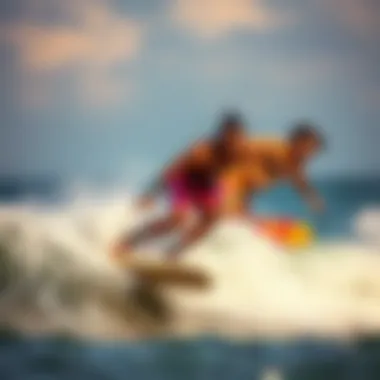
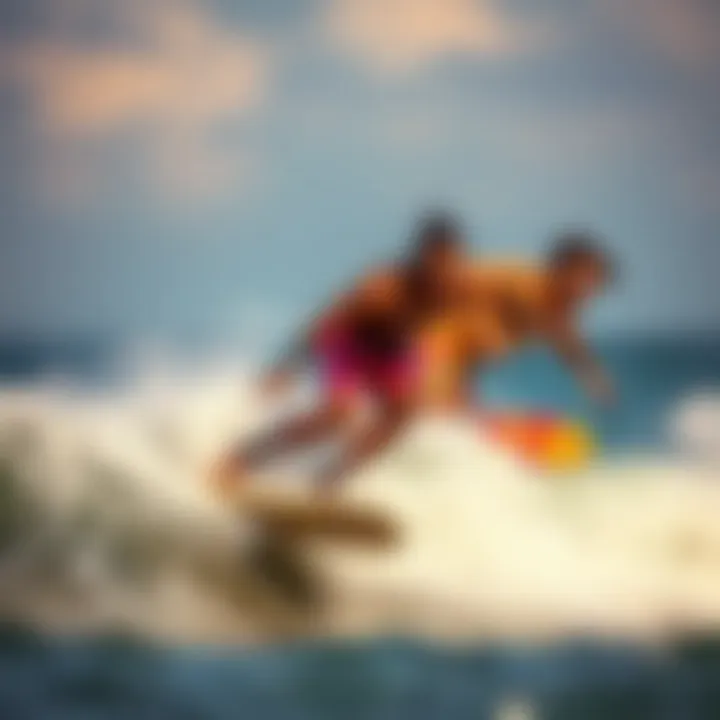
Additionally, physical conditioning plays a crucial role. The boneless demands strength and flexibility in the legs and core. Surfers who neglect their physical preparation often find themselves struggling to execute the move seamlessly. Therefore, incorporating exercises that build leg strength, like squats or lunges, can help bridge the gap between aspiration and achievement.
Moreover, the boneless is prone to common mistakes, which can frustrate novice users:
Common Mistakes
Many surfers make several missteps as they attempt to nail the boneless. Here are a few pitfalls to watch out for:
- Incorrect Foot Placement: Some surfers either overextend their back foot or don’t position it correctly on the board. This misalignment can throw off balance, making the maneuver more difficult.
- Lack of Momentum: When trying to perform a boneless, it's easy to underestimate the importance of speed. Not generating enough momentum can limit the execution of the trick.
- Not Committing: Hesitation can lead to half-hearted attempts. Surfers often hold back, afraid to fully extend their body, which results in a subpar execution. Full commitment is vital.
By understanding these potential blunders, surfers can be better equipped to correct them and build confidence in their ability to perform the boneless.
Overcoming Fear and Injury
Fear and the concern of injury often loom large when attempting any new surfing technique. The boneless is no exception. Overcoming these mental barriers requires a two-pronged approach: awareness and preparation.
Building Awareness
Surfers should familiarize themselves with the move by studying videos and consulting experienced surfers. Knowing what to expect can significantly reduce anxiety before attempting it. Watching others perform the boneless lends a sense of assurance that it’s achievable.
Physical Preparation
Preparing the body for the rigors of surfing is also non-negotiable. Regular cross-training can build the necessary strength and agility, decreasing the risk of injury. Key exercises include:
- Balancing drills on a board or balance ball
- Aerobic exercises to boost endurance
- Stretching routines to enhance flexibility
In some cases, it may be beneficial to invest time in basic surfing techniques before tackling the boneless. Building a solid foundation by refining one’s general surfing skills can ease fears as confidence grows. Remember, every accomplished surfer has, at one time or another, been in the same boat.
"The journey to mastering the boneless is not a straight line; it often resembles a series of waves—some daunting, others exhilarating. Embracing both success and setback is key."
In summary, while the challenges in mastering the boneless can seem daunting, they also present opportunities for surfers to grow both in skill and mentality. With persistence, awareness, and a little preparation, every surfer can ride the waves of progression.
Future of the Boneless Technique
As the boneless technique continues to carve its niche within surfboarding, its future presents a unique canvas for innovation and evolution. Staying relevant in the sporting world demands adaptation and creativity, particularly as new generations of surfers take to the waves. This section will delve into the specifics of what lies ahead for the boneless technique.
Innovations in Surfboarding
The landscape of surfboarding is constantly changing due to advancements in technology and shifts in culture. These innovations radically transform how surfers approach techniques like the boneless.
- Material Advances: Boards have seen significant technological upgrades. New composite materials make boards lighter and more responsive. This helps in executing tricks with precision. Surfers can perform boneless maneuvers with less effort, leading to better execution and creativity in their routines.
- Performance Analytics: Devices and apps are now available to analyze performance metrics in real time. This data-driven approach provides surfers with insights into how they can refine their technique. Surfers can focus on the biomechanics of the boneless dance, improving every tiny movement.
- Virtual Reality Training: Imagine slipping on a VR headset and stepping into a simulated ocean where you can perfect your boneless without the fear of wipeouts. Such technologies are enhancing training methods, allowing surfers to visualize and practice techniques in a controlled environment.
The marriage of these innovations with existing techniques not only sharpens performance but also expands the aesthetic possibilities within the surf culture. Innovative tools will undoubtedly lead to refined skills and an explosion of creative expression.
The Boneless in Upcoming Competitions
The competitive arena is where the boneless can truly shine as it is often a test of skill, creativity, and fearlessness. As surf competitions continue to evolve, the reliance on traditional moves needs to be reassessed. The boneless stands out as a key player for a myriad of reasons.
- Judging Systems: Competitive surfing is slowly adopting a more holistic approach to judging, focusing on creativity and technical skill over merely “functional” rides. The boneless, with its signature flair, aligns perfectly with this shift. Its inclusion in more competitions can entice judges to reward uniqueness and execution.
- Rising Stars: With new talent emerging consistently, there’s a fresh emphasis on originality. Competitive surfers are likely to experiment even more with the boneless, embedding it into their routines in new and exciting ways. Will the next generation of riders take this technique to unprecedented heights?
- Diversity in Derivatives: Expect to see variations of the boneless introduced in competitions. Creative combinations that integrate styles from other sports can emerge. Whether it’s a boneless partnered with a similar move from skateboarding or snowboarding, the sky is the limit.
Finale
The journey through the boneless skate encapsulates not just a surf technique but a significant aspect of surf culture. It represents the evolution of styles, the merging of creativity and athleticism, and the ongoing conversation among riders and communities. Understanding the nuanced history and context of the boneless allows enthusiasts to appreciate its role in shaping modern surf practices.
Recapping the Boneless Journey
The boneless technique has traveled quite the road since its inception. What started as an experimental maneuver has morphed into a fundamental element of surfing culture. From its origins in the hands of early surfers like Christian Fletcher to becoming a standard trick performed in competitions, the boneless encapsulates the spirit of innovation that characterizes the surf community. This art of combining style and technical proficiency continues to evolve, engaging new generations of riders. An essential takeaway from this exploration is how the boneless, while simple in execution, embodies deeper themes of creativity and originality in the art of surfing. Each flip of the board is a testament to a rich history that countless surfers have contributed to.
The Boneless as an Extension of Surf Identity
In many ways, the boneless skate technique serves as an extension of a surfer’s identity. It allows surfers to express themselves uniquely on the waves, showcasing their personal style and creativity. Riders who master this maneuver often find it becomes a signature move, one that defines their presence in the surf community. Furthermore, the technique represents a bridge between various surf subcultures and the diverse backgrounds of its practitioners. This blending of styles — from traditional longboarding to modern shortboard tricks — illustrates how the boneless is more than just a move; it's a cultural statement.
The connection between a surfer and the ocean is profound, and the boneless encapsulates this relationship. It's about transcending the limitations of the board and creating a dialogue between rider and wave. Understanding this technique and its backdrop enables surfers to not only refine their skills but also to feel a deeper connection to the broader surf lineage and community.
"The boneless skate isn't just about performing a trick; it's a way to tell your story on the water."
The exploration of the boneless skate technique highlights its evolution, significance, and the ongoing influence it has within the realm of surfing. Whether you’re a seasoned pro or a curious beginner, appreciating this technique as part of the surf identity enriches your experience on the waves.



